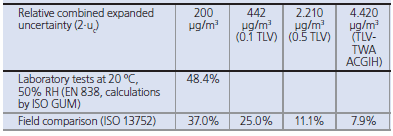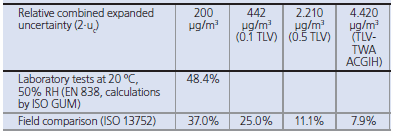Radiello Diffusive Sampler for Monitoring 1,3-Butadiene and Isoprene in Workplace Air
Introduction
The manufacturing of elastomers makes wide use of 1,3-butadiene (CAS No. 106-99-0) and isoprene (2-methyl- 1,3-butadiene, CAS No. 78-79-5). Both compounds are classifi ed as carcinogenic by the International Agency for Research on Cancer (IARC). 1,3-Butadiene is currently listed in group 1, carcinogenic for humans, and isoprene is in group 2B, possibly carcinogenic for humans. These compounds may also be present in lower concentration in the environment (lower ppb levels).
The measurement of these compounds in workplace air requires high sensitivity and also the control of explosive hazards, which are frequent in chemical plants. Diffusive sampling followed by thermal desorption and GC-MS analysis represents a simple and affordable tool for this measurement, while satisfying the above requirements.
In general, the measurement of volatile organic compounds (VOC’s) suspected of carcinogenic properties in workplace air requires high sensitivity, down to ppb level. The existing methods for the measurement of 1,3-butadiene involve the pumping of air through activated charcoal or molecular sieves, followed by solvent or thermal desorption and gas chromatography1-2. Methods based on solvent desorption are inherently less sensitive because the sample is diluted by a factor of about 1,000 during extraction. Thermal desorption, when performed by two-stage thermodesorbers (desorption and concentration/trapping step), have a typical “dilution” factor of 50-100, arising from the combination of secondary and primary split, which are adjustable depending on the expected amount of analytes.
More recently, methods based on diffusive sampling onto molecular sieves or graphitized carbon blacks, were proposed3-4. However, the sampling rates of such methods, based on axial diffusion tubes, are lower than 1 mL/min and do not allow ppb level sensitivities. The use of radial symmetry diffusive samplers like Radiello®, provide commonly higher sampling rate values5 in combination with thermal desorption and allow the measurement of 1,3-butadiene and isoprene in workplace air with a sensitivity in the ppb range.
Sampling
The sampling of 1,3-butadiene and isoprene with Radiello diffusive samplers is performed using an adsorbing cartridge (4.8 mm diameter stainless steel net), packed with Carbopack™ X, the strongest adsorbent in the range of Supelco graphitized carbons, with a specifi c surface area of 240 m2/g6. The sampler is easily assembled by placing the cartridge into a yellow diffusive body RAD1202 (Figure 1), and attaching it to the triangular support plate (RAD121); once assembled, the sampler is typically exposed during the entire work shift (8 hours). After sampling, the adsorbing cartridge is placed again in the glass storage/transport container and the barcode label is placed on the container. Prior to analysis, the samples should be kept cold and stored in the freezer. Time until analysis should not exceed 24 hours.

Figure 1:Radiello Cartridge in Yellow Diffusive Body
Analysis
The analysis of diffusive samples includes two-stage thermal desorption (TD), followed by HRGC-MS. The sample loaded adsorbing cartridge is transferred into an empty SS thermal desorption tube (¼ inch O.D., min. 4.9 mm I.D.), which is then placed into the TD instrument. The collected sample is desorbed by heat and transferred onto a GC column.

When choosing the proper GC column, the potential interference from other C4 alkenes, which may occur in real samples, like 1-butene, 2-butene (trans- and cis-) and isobutylene must be taken into account.
Calibration
The calibration standards for 1,3-butadiene can be prepared by the gas syringe spiking procedure, using a gastight microsyringe (10 μL or more) and measured volumes of either pure or 1:50 diluted gas that is loaded onto the Carbopack X cartridges fi tted into an empty SS thermal desorption tube that is connected to a GC injector (40 mL/ min nitrogen purge stream). Cartridges used for preparing calibration cartridges should have a tight fi t in the TD tube (slight resistance when pushing in tube) to ensure a reliable adsorption of standard volume. The isoprene calibration standards are prepared by injecting measured volumes of a methanol solution of the analyte.
The analysis is best performed within 24 hours after the exposure. If the analysis is performed later, the storage requirement of the EN 838 standard (7) is satisfi ed within 14 days of storage. In such a case, the maximum analyte loss is 7% for 1,3-butadiene and 8% for isoprene, which is less than the maximum loss (10%) allowed by the standard (7).
Calculation
The concentration C of 1,3-butadiene and isoprene determined by diffusive sampling are calculated by the general equation:
C(μg/m3)=
[(m(ng)-mb(ng))* 1000]/
[Q(cm3/min)* t(min)]
where m = sampled mass of the analyte
mb = mass of the blank (usually negligible)
Q = diffusive uptake rate
t = exposure time
The diffusive uptake rate values for both compounds (Table 1) were determined according to EN 838, which gives guidance for using diffusive samplers in workplace air monitoring7.
The combined effect of temperature and humidity may affect the sampling rate, with a significant decrease at high temperature and high humidity (40 °C and 80% RH); therefore it is recommended to avoid taking measurements when such extreme conditions are expected. At lower temperatures (5 °C), the effects are comparable and small. A field validation on 40 workers (18 °C temperature and 75% relative humidity, on average) demonstrated that the measured concentrations agree with the results obtained by the OSHA method 56 (solvent desorption from TBC-treated charcoal and GC). The results obtained with Radiello samplers, plotted against the results of OSHA 56 method, show a regression line with slope very close to 1 and no significant intercept (data not shown).

Table 1.Diffusive Uptake Rate for 8 Hour Exposure at 20 °C, 50% RH
Measurement of Uncertainty
Table 2 shows the values of the uncertainty in the measurements of 1,3-butadiene in the workplace, assessed by two different approaches. The uncertainties were fi rst determined under laboratory conditions, following the methods of the ISO GUM (Guide to Expression of Uncertainty in Measurement, International Organization for Standardization, Geneva, 1993) and ISO 5725:1994 (Accuracy, trueness and precision of measurement methods and results). In this case, the uncertainty accounts for all contributions involved in the measurement process (effect of time, T, RH on uptake rate, uncertainty of measured mass and so on), which were determined according to EN 838:1995. Afterwards, the uncertainty was determined by a fi eld comparison with the method OSHA 56 (as the reference method), following the standard ISO 13752.

Table 2. Measurement Uncertainty for 8 Hour Diffusive Sampling of 1,3-Butadiene in Workplace Air
Conclusions
The thermal desorption Radiello sampler fi lled with Carbopack X represents a new and simple tool for assessing the workplace exposure to two carcinogenic chemicals: 1,3-butadiene and isoprene at ppb concentration levels. It is convenient in use and can be applied for any workplace where explosive hazards exist.
References
To continue reading please sign in or create an account.
Don't Have An Account?